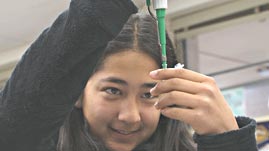Teachers' Domain - Digital Media for the Classroom and Professional Development
User: Preview

Source: Produced by WGBH Educational Foundation in association with the Amgen Foundation



In this video produced by WGBH, high school and middle school students in the Amgen-Bruce Wallace Biotechnology Lab Program make use of research equipment and techniques identical to those used in academia and industry to separate DNA. Data generated from this kind of experiment can help researchers analyze DNA and the genetic make-up of humans in an effort to understand how and why diseases develop that affect millions of people. This kind of research can also lead to the development of drugs for disease treatment and/or vaccines for disease prevention.
The techniques used in biotechnology help researchers understand how genetic factors contribute to human disease. Inherited genes that reside on human chromosomes and code for the production of proteins may be faulty or otherwise damaged. As mentioned in this video, scientists can’t cure diseases such as Huntington’s, Alzheimer’s, and Parkinson’s without understanding how these faulty proteins function and behave inside cells.
In this lab, students use the same equipment and techniques employed by academic and industry researchers to separate and visualize pieces of DNA. When researchers identify a protein that may have therapeutic potential, they set out to locate and then isolate the gene that encodes that protein. Once isolated, the gene can be inserted into a plasmid to create a recombinant DNA molecule and then cloned using bacteria. The cloning of recombinant DNA allows researchers to obtain many copies of the gene of interest.
After a gene of interest is cloned in bacteria, it needs to be separated for further analysis. To separate DNA of interest from other DNA molecules, electrophoresis is commonly used. This technique separates these molecules on the basis of size. Once separated, the gene of interest can be selectively removed from the gel, and the DNA can be purified and sequenced. Bacteria containing the gene of interest can later be used to express the protein of interest. A protein of interest can also be separated using similar gel electrophoresis techniques.
Biotechnology research is often about making small breakthroughs in understanding on a very small (molecular) scale. Yet some of these small breakthroughs have the potential to generate significant improvement in the quality of life for millions of people.
 Loading Standards
Loading Standards